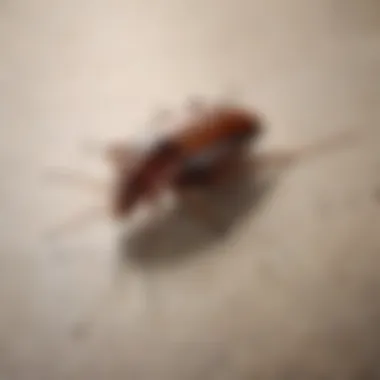Effective Strategies to Eliminate Roaches from Your Home


Intro
Roaches are not just a nuisance; they pose significant health risks. Their presence in a home can indicate poor sanitation, making it essential to address any infestation promptly. As they reproduce quickly, small infestations can turn into major problems if left unchecked. This article aims to provide a thorough understanding of how to rid your house of these pests effectively.
Understanding the habits and habitats of roaches is a vital step in both elimination and prevention. The German cockroach, for instance, is commonly found in kitchens due to its preference for warmth and food sources. Other species, like the American cockroach, might invade basements and plumbing spaces. Each type comes with unique challenges requiring specific approaches for elimination and prevention.
By exploring both natural and professional treatment options, this article hopes to empower homeowners and renters. By the end, you will have a systematic approach to not just remove roaches but also to create an environment that discourages their return.
Understanding Roaches
Roaches are not just a nuisance; they pose significant health risks and can indicate broader sanitation issues in the home. Understanding roaches, including the types most often found indoors and their behavior, is crucial for effective management. Knowledge of their habits and habits aids in targeted actions for eradication. Roaches multiply quickly, and having insight into their lifecycle and preferences can help mitigate infestations before they escalate.
Species Identification
Common Species Found Indoors
There are several roach species that commonly invade homes. Notably, the German cockroach and the American cockroach are frequent culprits. German cockroaches thrive in warm, humid conditions, making kitchens and bathrooms prime targets. Their size and fast reproduction make them a major concern. American cockroaches, larger in size, prefer dark, moist areas such as basements and sewers.
Understanding these species helps homeowners choose the right control measures. Each type requires different approaches; thus, identifying the specific species can make the management more effective.
Distinguishing Features
Distinctive features, like coloration and size, play a vital role in identifying roach species. For example, German cockroaches have a light brown color with two darker stripes running down their backs. Meanwhile, American cockroaches are a reddish-brown and can grow up to two inches long. Recognizing these differences assists in implementing targeted interventions.
Knowing the distinguishing characteristics helps in confirmation and strategy planning. Misidentifying roach species can lead to inappropriate control methods, prolonging the issues at hand.
Behavioral Patterns
Feeding Habits
Roaches are omnivores and exhibit varied feeding habits. They often consume crumbs, grease, and organic material. This dietary flexibility makes them resilient and adaptable in various environments. Understanding their food preferences can direct cleaning efforts to areas where food sources lie.
Maintaining cleanliness can significantly reduce their food availability. Sealing food containers and cleaning up after meals minimizes access to these resources, effectively curbing infestations.
Reproduction Rates
Roaches reproduce rapidly, making it essential to understand their reproduction rates for successful management. A single female German cockroach can give birth to around 30 to 40 offspring in just a few months. This high reproductive capability means that early intervention is key. Recognizing this characteristic helps homeowners realize the urgency of addressing roach problems.
Strategies that target both adults and their eggs can significantly control populations. Pest management should focus on reducing breeding sites, a crucial step in the combat against infestations.
Preferred Environments
Understanding the environments roaches prefer is important for prevention. Roaches thrive in warm, dark, and moist areas. They often hide in places like behind appliances, inside cabinets, and in cracks and crevices.
By identifying these preferred environments, homeowners can take measures to reduce suitable habitats. Keep spaces dry and well-lit. Clearing clutter and sealing potential hiding places are effective preventive actions.
Signs of Infestation
Physical Evidence
Physical signs of a roach infestation can vary. Common indicators include droppings, egg cases, and shed skin. Droppings look like small black pepper, while egg cases, or oothecae, are elongated and dark brown. Finding these signs can reveal infestation levels and guide removal efforts.
Checking areas prone to infestation is important. Regular inspections can catch infestations early, making control efforts more successful.
Smells and Sounds
Roaches emit a musty odor, often detectable when populations are high. Some people may also hear rustling noises at night when roaches are active. Identifying these subtle signs can lead to early intervention.
Being aware of smells and sounds helps homeowners stay alert to potential infestations. Prompt action can prevent widespread problems and maintain a healthy living environment.


Preventive Measures
Preventive measures are vital in managing roach infestations. These methods aim to create an environment where roaches cannot thrive. By implementing preventive strategies, homeowners can significantly reduce the likelihood of an infestation from the start. It is not only about reactive measures, but also about fostering conditions that make your home less inviting to these pests. Preventive actions can save time, money, and effort in the long run.
Maintaining Cleanliness
Maintaining cleanliness in all areas of the home plays a key role in controlling roaches. A clean environment does not provide food sources or shelter for these pests, helping to keep them at bay. When cleanliness becomes a habit, residents can drastically reduce factors that attract roaches.
Proper Food Storage
Proper food storage is essential. It involves keeping food sealed and stored in containers that roaches cannot penetrate. This practice helps eliminate easy access to food, which is a primary attraction for roaches. Using glass or hard plastic containers is a popular choice because they are durable and airtight.
The most important aspect is consistency. Leaving food out, even for a short time, can encourage infestations. This method also helps in preserving food quality and minimizing waste, as food stays fresh longer.
Regular Cleaning Schedules
Implementing regular cleaning schedules is crucial. This process involves a systematic approach to cleaning various parts of the home, like kitchens and bathrooms. It ensures that crumbs, spills, and food residues do not accumulate over time. The frequency of these cleanings can vary, but at minimum, weekly cleaning is effective.
The key characteristic of a good cleaning schedule is organization. When households prioritize cleaning, it becomes routine, leading to consistent prevention. However, sometimes, it can be easy to overlook hard-to-reach places. These areas should not be neglected, as they often host roach activity.
Sealing Entry Points
Sealing entry points is another important preventive measure. Roaches can enter homes through the smallest openings. By addressing these gaps, homeowners can control potential pathways for roaches to invade.
Identifying Cracks and Gaps
Identifying cracks and gaps requires a methodical inspection of the home. Focus areas include doors, windows, and foundation cracks. Once identified, homeowners can take action. This process is essential because it stops roaches before they enter. A key feature of this measure is thoroughness. Missing even small gaps can mean more roaches in the future.
Keeping an eye on these entry points creates a formidable barrier against pests. However, it may involve time and effort to discover all problematic areas.
Using Sealants Effectively
Using sealants effectively follows the identification of entry points. Sealants like caulk or foam can fill gaps, ensuring that they stay closed. This offers a long-term solution against infesting pests. A major benefit of sealants is their accessibility; they can be found in most hardware stores and are relatively easy to apply.
However, it's essential to choose the right type of sealant for the job. Improper sealing can lead to deterioration and gaps reopening. Homeowners should check sealants periodically to maintain effectiveness over time.
Managing Humidity Levels
Managing humidity levels contributes to a less hospitable environment for roaches. High humidity can attract roaches, as they thrive in moist conditions. Controlling moisture not only helps reduce roach populations but also enhances overall home comfort.
Utilizing Dehumidifiers
Utilizing dehumidifiers is an effective strategy for managing humidity. These devices draw moisture from the air and can significantly lower indoor humidity levels. This is especially beneficial in areas prone to dampness, such as basements. The best characteristic of dehumidifiers is their ability to create a drier home environment, making it less inviting to roaches.
A negative aspect can be the initial cost of purchasing a good unit. However, the investment pays off by preventing potential infestations and health issues.
Fixing Water Leaks
Fixing water leaks is crucial for long-term control. Leaks create damp spots that attract roaches. Therefore, homeowners should regularly check plumbing systems for signs of leaks. Promptly addressing any leaks prevents an easy breeding ground.
The key aspect of this measure is proactivity. Noticing leaks early can make repairs simpler and less costly. However, some leaks can be hidden and may require professional evaluation to discover.
"Preventing roaches from entering your home is not only about blocking access but also about creating an unwelcoming environment for them."
These preventive measures create a foundation for effective roach management. By being vigilant and attentive to cleanliness, sealing entry points, and managing humidity levels, homeowners can create an environment that deters roaches effectively.
DIY Roach Control Methods
The topic of DIY roach control methods can be crucial for homeowners who wish to manage pest problems without immediately resorting to professional extermination services. These methods can save money and also provide peace of mind by allowing individuals to take matters into their own hands. This section will outline various DIY approaches, focusing on natural remedies, homemade traps, and the use of essential oils. Each method has its own benefits and considerations to help you create a comprehensive strategy against roaches.
Natural Remedies


Boric Acid
Boric acid is a well-known substance in pest control, particularly for addressing roach infestations. It acts as a desiccant that disrupts the roach's ability to retain moisture, which eventually leads to its demise. One key characteristic of boric acid is its ability to target the entire colony rather than just individual insects. This makes it a beneficial choice for those dealing with a significant infestation.
However, there are certain disadvantages to consider. Boric acid can be toxic to pets and children if ingested, so it is essential to apply it in places that are inaccessible to them. Additionally, while it is effective, it may take some time to observe results since the roaches must consume enough of it to affect their overall health.
Baking Soda and Sugar
Using a mixture of baking soda and sugar is another effective DIY method to tackle roaches. The sugar acts as bait, attracting roaches, while the baking soda causes a build-up of gas in their system once ingested. This combination is advantageous for its simplicity and safety, as both ingredients are common household items.
Despite its popularity, this method has unique features and limitations. It may not be as potent as chemicals, and its success largely depends on the number of roaches present. Furthermore, repeated applications may be needed to maintain effectiveness.
Homemade Traps
Jar Traps
Jar traps present a practical way to catch roaches. A simple jar filled with water, along with a few drops of oil on the surface, can act as an effective barrier. The roaches that fall in cannot escape due to the slippery surface. This method is appealing because it is non-toxic and inexpensive.
Nevertheless, it has some downsides. Jar traps may require frequent checking and emptying. If you have a significant infestation, these traps alone might not suffice in eliminating all pests.
Dish Soap Solutions
Dish soap solutions can be another effective homemade trap. A mixture of dish soap and water can be sprayed directly on roaches or set in shallow dishes. The soap suffocates roaches as it clogs their breathing pores, providing an immediate solution. This method stands out due to its ease of preparation and low-cost materials.
However, while it can offer fast results, it may not be a comprehensive long-term solution. Continuous application might be necessary for extended periods to manage recurring infestations, and it may not address breeding issues effectively.
Essential Oils
Using Peppermint Oil
Peppermint oil is often highlighted for its natural pest-repelling qualities. Its strong scent is known to deter roaches, meaning that it can work as both a prevention and control method. As a repellent, peppermint oil is non-toxic and safe for indoor use, which makes it appealing for households with children or pets.
On the downside, while peppermint oil has good repellent properties, it may not eliminate the problem entirely. You may have to combine it with other methods for better effectiveness.
Effects of Lavender Oil
Lavender oil is also known for its ability to repel roaches and contribute to a pleasant-smelling home. The calming fragrance not only helps purify the air but also works against various pests including roaches. Like peppermint, lavender oil is non-toxic and safe for internal environments.
However, the effect may not be as potent as chemical solutions. Plus, using essential oils requires a more proactive approach, meaning regular applications are necessary to maintain a barrier against infestations.
Commercial Pest Control Options
Commercial pest control options play an essential role in addressing and eliminating roach infestations effectively. While DIY methods can provide temporary relief, the comprehensive approach offered by professional services often yields more lasting results. Engaging expert services allows for a deeper understanding of the pest problem by utilizing advanced methodologies and equipment.
In many cases, the complexities involved in pest management require professional expertise. These companies not only eliminate the current infestation but also address preventive measures that ensure roaches do not return.
Pesticides
Types of Pesticides Available
Pesticides used for roach control come in different formulations. These include sprays, gels, and baits. Each type has distinct characteristics that contribute to its effectiveness in cockroach management. For example, gel baits attract roaches and contain a slow-acting poison, allowing them to return to their nests and share the toxin with others. This trait makes gel baits a popular choice due to their targeted application and lower immediate toxicity to humans and pets.
On the other hand, insecticide sprays offer a more immediate, albeit short-term, effect. These can kill roaches on contact and are helpful in severe infestations. However, their lasting effect is limited, and they may need reapplication. The choice of pesticide often depends on the level of infestation and the specific environment in which it will be used.
Safe Application Techniques
Safe application techniques are paramount for minimizing health risks associated with pesticide use. One key characteristic of these techniques is following the instructions provided by manufacturers meticulously. This ensures that the products are used in their intended manner and reduces hazards to humans and non-target animals.
Moreover, application in well-ventilated areas and the use of protective gear can enhance safety. It is also beneficial to restrict access to treated areas until the product has dried or set, which minimizes potential exposure to any harmful residues. These unique features help maintain a balance between effective pest control and safety.
Professional Extermination Services


Choosing a Pest Control Company
Selecting the appropriate pest control company is a critical decision. Various elements come into play, such as the company’s reputation, customer reviews, and the range of services offered. A well-established, experienced company often demonstrates a commitment to solving pest problems effectively.
Another aspect to consider is the methods they employ. Companies should utilize Integrated Pest Management (IPM) strategies, which focus on a combination of practices to manage pests in an environmentally friendly way. The advantages of choosing an experienced professional include enhanced knowledge and the ability to tailor solutions to individual infestations.
Expectations from Professional Services
Understanding what to expect from professional extermination services is crucial. A well-designed extermination service generally begins with a thorough inspection of the premises. The aim is to identify pest hotspots and the source of infestations. Following this, exterminators devise a tailored treatment plan. This methodical approach ensures that all factors contributing to the infestation are addressed.
Additionally, professional services often provide follow-up evaluations to assess the effectiveness of the treatments. Clients should expect transparency about methods used and what steps they need to take to maintain a pest-free environment. This guidance helps to establish a sustainable solution rather than a quick fix.
Ongoing Maintenance
Scheduled Treatments
Scheduled treatments are a proactive measure in pest management. This approach involves regularly scheduled inspections and treatments to prevent reinfestation. The main advantage of this system is that it keeps pest populations suppressed, making significant infestations less likely. It creates a consistent line of defense against any emerging threats.
Another key aspect is the establishment of a relationship with the pest control provider. Engaging regular services also means that the pest control company becomes familiar with the client’s specific situation and environments. This familiarity enhances the effectiveness of ongoing services.
Monitoring for Reinfestation
Effective monitoring for reinfestation is vital in managing future pest issues. This involves continuous observation of previously infested areas, ensuring that any signs of new activity are recognized promptly. One highlight is the use of monitoring devices or traps, which can provide visual indicators of pest activity and serve as an early warning system.
The unique feature of this monitoring is that it allows for rapid response, minimizing the extent of any new infestations. Regular monitoring also contributes to improved long-term strategies by adapting preventative measures based on observed pest behavior. This adaptability is advantageous for maintaining a pest-free home.
Health Implications of Roach Infestations
Roaches are not only a nuisance but also pose serious health risks. Their presence can lead to various health problems, affecting people’s well-being. Understanding these implications is essential for anyone dealing with roach infestations. By recognizing how roaches can impact health, individuals can take more deliberate steps to address the issue. This section delves into how roaches can contribute to allergies, asthma issues, and food contamination concerns.
Allergens and Asthma Triggers
Understanding Allergies
Allergens from roaches are a significant concern. The droppings, saliva, and body parts of these pests contain proteins that are known allergens. Many people may be unaware of their sensitivity until they encounter an infestation. Studies show that exposure to roach allergens can worsen asthma symptoms and lead to respiratory issues. Recognizing this connection is vital. It emphasizes the need to act promptly when roaches are spotted in the home. Addressing this aspect will help in overall health management and ensure a cleaner living environment.
Reducing Risk Factors
Reducing risk factors associated with roach exposure is crucial. This means minimizing the chances of allergen contact. Regular cleaning and effective pest control strategies can significantly decrease the presence of roach allergens in the home. Removing potential hiding spots for reseach, and using air purifiers can help improve indoor air quality. Understanding this concept allows homeowners to take proactive measures. It creates a healthier atmosphere for all residents, particularly those with allergies or asthma.
Food Contamination Concerns
Preventing Foodborne Illness
Foodborne illness caused by roaches is a valid concern. Roaches are known to carry pathogens that can contaminate food. When they crawl over food surfaces, they can transfer bacteria and other harmful agents. Proper food storage and cleanliness in the kitchen area can drastically reduce these risks. It's imperative to keep food covered and stored correctly, thus minimizing contamination chances. This awareness plays a critical role in maintaining health standards in the home.
Safe Food Handling Practices
Implementing safe food handling practices is necessary to prevent potential health issues. Basic rules such as washing hands before handling food and ensuring cleanliness in food prep areas are essential. Education on these practices can prevent the spread of illness. Furthermore, understanding that roaches can contribute to food contamination highlights the importance of these efforts. This practice not only protects food but also fosters a safer environment for everyone.
Ending
Addressing roach infestations is crucial for maintaining a healthy living environment. Roaches are not just unsightly; they also pose significant health risks. This section highlights the importance of the concluding strategies discussed throughout the article.
Recap of Key Strategies
The key strategies to rid your house of roaches include several approaches:
- Identification: Understand the species of roaches present, as this influences your control method.
- Prevention: Maintain cleanliness and seal entry points to avoid attracting roaches. Regular cleaning helps keep your environment unfriendly to them.
- DIY Control: Utilize natural remedies such as boric acid and baking soda mixed with sugar. Homemade traps can also be effective.
- Commercial Options: Don’t overlook professional extermination services if the infestation is severe. Safe application of commercial pesticides is essential.
All these strategies reinforce one another and contribute to a comprehensive approach. It is not enough to implement one single method; a multifaceted strategy increases the chances of eradication.
Final Thoughts on Roach Management
Roach management should be viewed as an ongoing process. After successfully eliminating roaches, it is vital to remain vigilant. Implementing scheduled maintenance checks and keeping up with cleanliness routines are necessary to prevent future infestations. The ultimate goal is to foster an environment that discourages roaches from returning.
Being proactive about these strategies not only leads to immediate results but also helps ensure long-term success in managing and preventing roach problems. Thus, understanding the behavior and biology of roaches, combined with practical strategies, forms the cornerstone of effective pest management.



